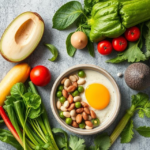Lady finger (Bhindi), or okra, is a beloved vegetable in Indian households—known for its unique texture, taste, and numerous health benefits. Rich in fiber, folate, and antioxidants, it is often recommended for diabetic, heart, and digestive health. However, Ayurveda, the ancient Indian system of medicine, reminds us that not all food combinations are beneficial. What you eat with bhindi can either support your digestion or disturb it, leading to toxins (Ama), allergies, or imbalances in doshas (Vata, Pitta, Kapha).
In this article, we delve into the Ayurvedic perspective on food incompatibility (Viruddha Aahara), particularly focusing on what not to eat with bhindi. We’ll explore how incompatible foods affect your body, specific harmful combinations, and healthy alternatives to maintain balance and well-being.
Understanding Viruddha Aahara: The Science of Incompatible Foods
In Ayurveda, the concept of Viruddha Aahara refers to foods that are wholesome individually but harmful when combined due to their different energies (Virya), post-digestive effect (Vipaka), and digestive processes (Agni).
For example, milk and fish are both nutritious, but when consumed together, they are considered incompatible and can lead to skin diseases and digestive issues. Similarly, certain combinations with bhindi can also create imbalances or reduce its benefits.
Bhindi (Okra) in Ayurveda
In Ayurvedic texts, bhindi is referred to as a Kapha-increasing, slightly Pitta-pacifying, and Vata-balancing vegetable. It is:
Madhura (sweet) in taste
Snigdha (unctuous) and Guru (heavy to digest)
Shita Virya (cooling in potency)
Bhindi is particularly good for joint health, digestion, and skin, but due to its mucilaginous (slimy) nature, it needs to be cooked well and paired wisely to avoid indigestion or Kapha aggravation.
What Not to Eat with Bhindi: Ayurvedic Red Flags
Let’s explore specific foods and food groups that should not be consumed with bhindi according to Ayurvedic principles:
1. Dairy Products (Especially Curd and Milk)
Why it’s incompatible:
Bhindi is heavy and slimy, and when combined with milk or curd, which are also Kapha-enhancing, the result is an overload on the digestive fire (Agni). This can lead to the formation of Ama (toxins), causing bloating, mucus, skin issues, or even sinus problems.
Common mistake: Eating bhindi curry with curd or raita on the side.
What to do instead:
Pair bhindi with buttermilk tempered with cumin and ginger to aid digestion.
2. High-Protein Animal Foods (Eggs, Fish, Meat)
Why it’s incompatible:
Bhindi is plant-based and cooling, while animal proteins are heating and heavy. This contradictory energy confuses the digestive system, leading to indigestion, flatulence, and Ama.
Common mistake: Serving bhindi fry or bhindi masala with non-veg dishes in meals.
What to do instead:
Eat bhindi with lentils or mung beans for a balanced vegetarian protein source.
3. Fruits (Especially Citrus and Melons)
Why it’s incompatible:
Fruits, especially citrus or melons, digest quickly, while bhindi takes longer due to its fiber and slimy texture. Combining the two can cause fermentation in the gut, gas, and acidity.
Common mistake: Eating fruit salad or oranges immediately after a bhindi-based meal.
What to do instead:
Have fruits at least 30–60 minutes before or after meals to avoid incompatibility.
4. Potatoes
Why it’s incompatible:
Both bhindi and potatoes are starchy, Kapha-aggravating, and heavy, making the combination difficult to digest. This can lead to sluggish metabolism and mucus-related issues.
Common mistake: Bhindi-aloo sabzi, a popular Indian dish, might be comforting but isn’t ideal for Kapha-dominant people or those with weak digestion.
What to do instead:
Try combining bhindi with lighter vegetables like tomatoes or bell peppers.
5. Cold or Carbonated Beverages
Why it’s incompatible:
Cold drinks extinguish the digestive fire (Agni) and interfere with the proper breakdown of heavy vegetables like bhindi. This can cause indigestion and fatigue after meals.
Common mistake: Having a cold soda or lassi after a bhindi-rich lunch.
What to do instead:
Drink warm water or herbal teas like cumin-fennel tea after meals.
The Impact of Incompatible Combinations
According to Ayurveda, regular consumption of incompatible foods can lead to:
Skin diseases (eczema, acne)
Digestive disorders (bloating, gas, acidity)
Allergies
Reduced nutrient absorption
Weight gain
Mental fog and fatigue
Over time, it may also contribute to chronic conditions by weakening your Agni and increasing Ama.
Best Practices When Cooking and Eating Bhindi
To maximize the benefits of bhindi and avoid incompatibilities:
1. Use Digestive Spices
Add spices like turmeric, cumin, coriander, hing (asafoetida), and ajwain while cooking bhindi. These help reduce its sliminess and enhance digestion.
2. Cook Well, Avoid Raw
Bhindi should never be eaten raw. Its slimy texture can be difficult for the body to handle unless it’s properly cooked.
3. Eat Fresh and Warm
Avoid refrigerating bhindi for long or eating it cold. Consume it freshly prepared and warm for best digestion.
4. Mind the Quantity
Don’t overload your plate with bhindi. Even healthy foods can burden your system in excess.
Ayurvedic Alternatives and Meal Ideas
If you want to include bhindi in your daily meals, here are some compatible and healthy Ayurvedic combinations:
– Bhindi with Moong Dal (Yellow Lentils):
A light and nourishing combination that’s easy on the gut and rich in protein.
– Bhindi with Jeera Rice:
Add cumin and ghee to rice to aid digestion, making it a soothing meal.
– Bhindi with Roti and Mint Chutney:
Whole wheat roti and digestive mint chutney balance bhindi’s heaviness.
– Bhindi sautéed with Tomato and Ginger:
This combination supports Pitta balance and improves taste and digestibility.
Who Should Be Extra Cautious?
According to Ayurvedic dosha types:
Kapha types should limit bhindi and avoid combining it with other heavy foods.
Vata types benefit from bhindi but should cook it well with ghee and warming spices.
Pitta types can enjoy bhindi in moderation, but should avoid spicy bhindi dishes.
Conclusion
Bhindi is undoubtedly a nutritious and delicious vegetable, but Ayurveda reminds us that how and with what we eat it matters as much as the vegetable itself. Mixing incompatible foods may not always show immediate symptoms, but their long-term impact on digestion and dosha balance can be significant.
By avoiding combinations like bhindi with curd, milk, potatoes, and non-veg, and embracing spice-infused, sattvic, and seasonal meals, you can enjoy all the benefits that bhindi has to offer—without the unwanted side effects.
FAQs
Q1. Can we eat bhindi with curd?
No. According to Ayurveda, this is an incompatible combination that can disturb digestion and increase mucus formation.
Q2. Is bhindi good for digestion?
Yes, when cooked properly with digestive spices. Avoid combining it with other heavy or Kapha-increasing foods.
Q3. Can we eat fruits after bhindi?
Avoid eating fruits right after a bhindi meal. Wait at least 30 minutes for better digestion.
Q4. Can bhindi be eaten at night?
It’s best consumed during lunch. If eating at night, keep the portion light and pair with ginger or cumin.
Related posts:
 What Should Babies Eat During Rainy Season?
What Should Babies Eat During Rainy Season?
 Valentine’s Day: History, Significance, and Modern Perspective
Valentine’s Day: History, Significance, and Modern Perspective
 The Impact of Social Media on Food Culture: A Digital Revolution
The Impact of Social Media on Food Culture: A Digital Revolution
 How Street Food Reflects Local Culture: A Culinary Journey Around the World
How Street Food Reflects Local Culture: A Culinary Journey Around the World
 Holi Party Ideas: Food, Music, and Games for a Memorable Celebration
Holi Party Ideas: Food, Music, and Games for a Memorable Celebration
 Food is Medicine: Unlocking the Healing Power of Nutrition for Lifelong Health
Food is Medicine: Unlocking the Healing Power of Nutrition for Lifelong Health
